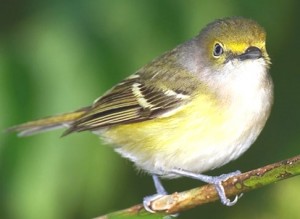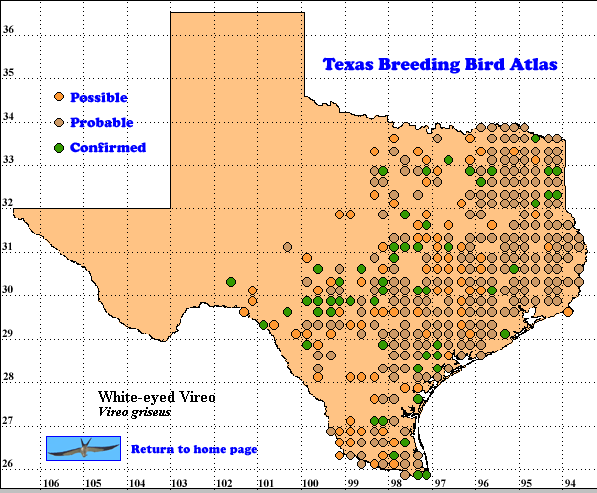The White-eyed Vireo, a skulker in dense brush, is more often heard than seen, but its songs and calls are distinctive. The species is considered closely related to 8 other vireo species, resident on islands of the Bahamas and Greater Antilles and in Middle America, but more study is needed to clarify these relationships (Hopp et al. 1995)
DISTRIBUTION. During the 1987-1992 field work of the TBBA project, volunteers found most White-eyed Vireo breeding records in the Pineywoods, Post Oak Savannah and Blackland Prairies, Coastal Prairies, Edwards Plateau, South Texas Brush Country and Coastal Sand Plain regions of Texas (as defined by Lockwood and Freeman 2004), The densest concentration of breeding records was found along the Louisiana border and the Gulf Coast.
North American Breeding Bird Survey (BBS) data indicate that the highest relative abundance is found in the southern Pineywoods region where observers found an average of 30-100 vireos per 40 km (25 mi) route during 1994-2003. Abundance declined gradually in all directions from here in agreement with trends shown on the TBBA map (Sauer et al. 2005).
In other states White-eyed Vireo breeds from central Iowa east across northern Illinois, Indiana, Ohio and Pennsylvania to the south coast of New England. The breeding range extends south to the Gulf Coast and along it to the state of Veracruz, Mexico. The western boundary extends southwest from central Iowa to Texas. In winter more northerly breeders more south to winter along the Atlantic coastal plain from North Carolina south and along the Gulf coastal plain to the Yucatan Peninsula and Belize as well as Cuba and the Bahama Islands (Hopp et al. 1995).
SEASONAL OCCURRENCE. White-eyed Vireo is present year-round along the Gulf coastal plain from the Louisiana border to Mexico. Northbound migrants from Mexico have been reported as early as February 23, with most arriving between mid-March and mid-May. Breeding occurs from March to mid-July, based on egg dates between April 10 and July 4. Extreme dates for fall migrants are July 14 and November 26 with most movement between late August and late October (Oberholser 1974, Lockwood and Freeman 2004).
BREEDING HABITAT. White-eyed Vireo breeds in Texas from near sea level to 270 m (900 ft). Favored breeding habitats include tangled thickets near water, damp brushy canyons and thick undergrowth. Both parents build the cone-shaped nest, suspended from the fork of twigs, 0.3-2.5 m (1-8 ft) above ground. The structure is woven of wood and bark shreds, held together with spider silk and lined with grasses and pine needles. The nest, indistinguishable from that of Bell’s Vireo (Vireo bellii), has an outside diameter of 7.5 cm (3 in), height 9 cm (3.5 in) and inside diameter and cup depth of 5 cm (2 in).
The female lays 3-4, mean closer to 4 dull white eggs, indistinguishable from those of Bell’s Vireo. Both parents share incubation for 13-15 days and the young leave the nest 9-11 days after hatching. Rates of brood parasitism by Brown-headed Cowbird (Molothrus ater) often are at least 50% and parasitized nests rarely produce vireos (Oberholser 1974, Harrison 1979, Hopp et al. 1995).
STATUS. Lockwood and Freeman 2004) rate White-eyed Vireo as a common to locally abundant summer resident and a common to uncommon spring and fall migrant in the eastern two-thirds of Texas. The breeding and summer records on Oberholser’s 1974 map define an area similar to the TBBA and BBS maps.
BBS data from 102 routes in Texas produce a 95% confidence interval (There is a 95% chance that the actual population trend will be between these two numbers.) of -2.3 t o +2.5% population change per year for the period 1966-2004. This is similar to the interval of -0.1 to+0.7% from 1195 routes on which the species was detected in the United States and Canada (Sauer et al. 2005).
The confidence intervals for both Texas and the total range north of Mexico are encouraging for the future of White-eyed Vireo, especially considering its high rate of brood parasitism.
Text by Robert C. Tweit
Literature cited.
Harrison, H. H. 1979. A field guide to western birds’ nests. Houghton Mifflin, Boston, MA.Hopp, S. L., A. Kirby and C. A. Boone. 1995. White-eyed Vireo (Vireo griseus). In The birds of North America, No. 168 (A. Poole and F. Gill, eds.). The Birds of North America, Inc., Philadelphia, PA.
Howell, S. N. G. and S. Webb. 1995. A guide to the birds of Mexico and northern Central America. Oxford University Press, New York.
Lockwood, M. W. and B. Freeman. 2004. The TOS handbook of Texas birds. Texas A&M University Press, College Station.
Oberholser, H. C. 1974. The bird life of Texas. University of Texas Press, Austin.
Sauer, J. R., J. E. Hines, and J. Fallon. 2005. The North American Breeding Bird Survey, results and analysis 1966-2004. Version 2005.1. USGS Patuxent Wildlife Research Center, Laurel MD (Web site, http://www.mbr-pwrc.usgs.gov/bbs).

